A poetry blog can be a great way to share your passion for poetry with the world, connect with other poets, and build an audience around poetry. But how do you get started?
This guide will show you how to start a poetry blog. We will cover everything you need to know including how to choose a niche, register a domain name, set up WordPress, and write blog posts. We’ll also discuss promotion and monetization strategies so you can make money from your blog.
By the end of this guide, you’ll have all the information you need to start a successful poetry blog that will help you achieve your writing goals.
If you have any questions along the way, just drop a comment and I will help you out.
So let us jump right in.

How to Start a Poetry Blog in 7 Steps
- Define Your Poetry Blogging Goals
- Choose a Poetry Niche
- Pick & Register a Blog Domain Name
- Setup WordPress
- Write & Publish Blog Posts
- Promote Your Poetry Blog
- Monetize & Make Money
1. Define Your Poetry Blogging Goals
Before you start a new poetry blog, it is important to define your goals. This will help you choose the right platform, content, and strategies for your blog.
Some common goals for poetry blogs include:
- Discussing poetry and different styles
- Sharing your work with the world
- Connecting with other poets
- Building an audience for your poetry
- Monetizing your blog
What is a Poetry Blog?
A poetry blog is a blog where writers share their passion for poetry. Poetry blogs can be used to discuss different styles of poetry, share poetry recommendations, provide criticism, share original poems, connect with other poets, build an audience around poetry, and make money selling poems.
Why Start a Poetry Blog?
There are many reasons to create a poetry blog. Maybe you want to improve your writing by getting feedback from other poets. Perhaps you’re looking for a way to connect with like-minded people who share your love for poetry. Or maybe you want to build an audience for your poetry so you can sell your work. No matter what your goals are, starting a poetry blog can help you achieve them.
2. Choose a Poetry Niche
One of the most important decisions you’ll make when starting a poetry blog is choosing a niche. A niche is a specific topic or audience that you will write for on your blog.
Why choose a niche?
There are many benefits to choosing a niche for your poetry blog:
- It will help you attract the right audience to your blog.
- It will make it easier to come up with ideas for blog posts.
- It will make it easier to promote your blog.
For example, if you write poems about nature, you can attract an audience of people who are interested in nature poetry. This will make it easier to come up with ideas for blog posts and promote your blog to people who are interested in reading nature poetry.
Finding Your Ideal Niche
There are a few ways to find a niche for your poetry blog. First, think about the topics you like to write about. What are your interests? What do you want to share with the world?
You can also look at other poetry blogs to see what niches are popular. What types of blogs are getting the most traffic? What topics do these blogs write about?
Popular poetry niches include:
- Poetry Recommendations
- Poetry Reviews & Criticism
- Poetry Writing Tips
- Limerick
- Free Verse
- Blank Verse
- Narrative Poem
- AcrosticBallad
- Haiku
Examples of Poetry Blogs
Now that you know some of the popular poetry niches, let’s take a look at some examples of successful poetry blogs.
[auto-list-number] Write Out Loud
This is a blog by poets for poets. The blog has articles on performance poetry, how to get published, and interviews with well-known poets. The blog also has a directory of poetry events around the world.
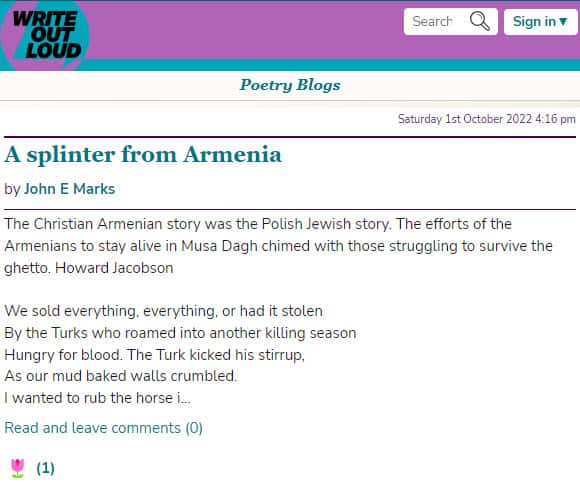
[auto-list-number] Magma Poetry
This is a blog by the editors of Magma Poetry magazine. The blog includes poems, reviews, articles, and interviews.

[auto-list-number] Poetry Foundation
The Poetry Foundation is one of the most popular poetry websites in the world. In addition to featuring poems from well-known poets, the site also offers resources for writers, including advice on writing and submitting poems.

[auto-list-number] Hello Poetry
Hello Poetry is a popular site that features poems from a variety of writers. The site also has resources for writers, including a library of writing prompts.
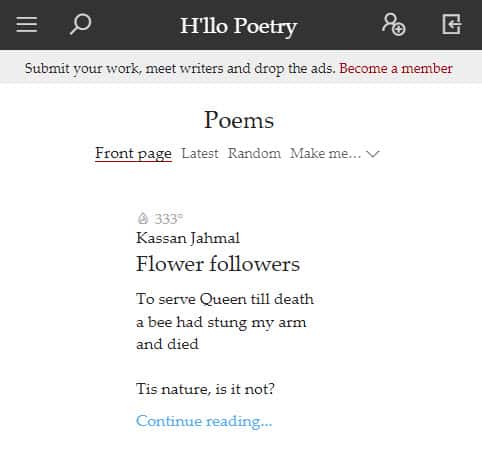
[auto-list-number] Phoebe MD
This is a blog by Phoebe Mitchelmore-Davies, a medical doctor and poet. The blog includes poems, reviews, and articles on the intersection of poetry and medicine.

3. Pick & Register a Blog Domain Name
Once you have chosen your niche, it is time to brainstorm a few names for your Poetry blog.
We recommend you keep your Poetry blog’s name to two words (Example: Hello Poetry). One of the two words should be a keyword from your niche. The other word can be something that makes your website brandable. For example, our blog teaches people how to make passive income, so we have named it Passive Book.
Here are some of the words that you can mix and match into your blog name:
- Poems
- Poet
- Poetry
- Poetic
- Verses
- Write
- Written
Use a Business Name Generator to brainstorm the name of your blog.
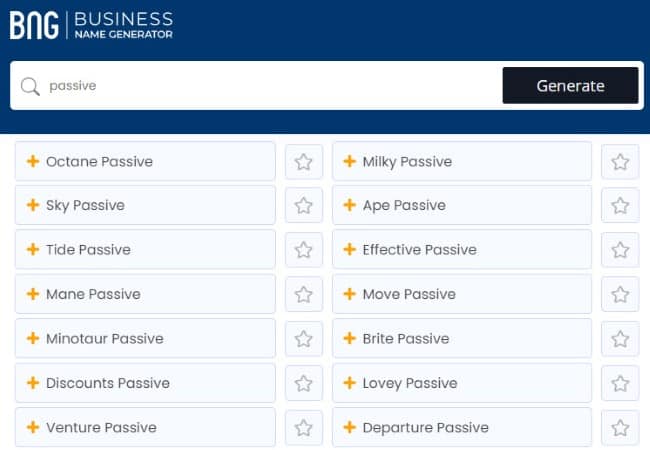
You can also use your own name for your blog. But if you ever plan to sell your website in the future, it is much more difficult to transfer your brand to the buyer when it is your name.
Check Domain Name Availability
After you have brainstormed a few names for your poetry blog, you should check if the .com domain name is available.
Your domain name is the address people will use to find your blog on the internet. For example, the domain name of our blog is passivebook.com. Usually, it is your blog name followed by an extension like .com.
You must check if both the .com domain name and the social media handles are available. You can use Namechk to check the availability of both your domain name and social media handles.
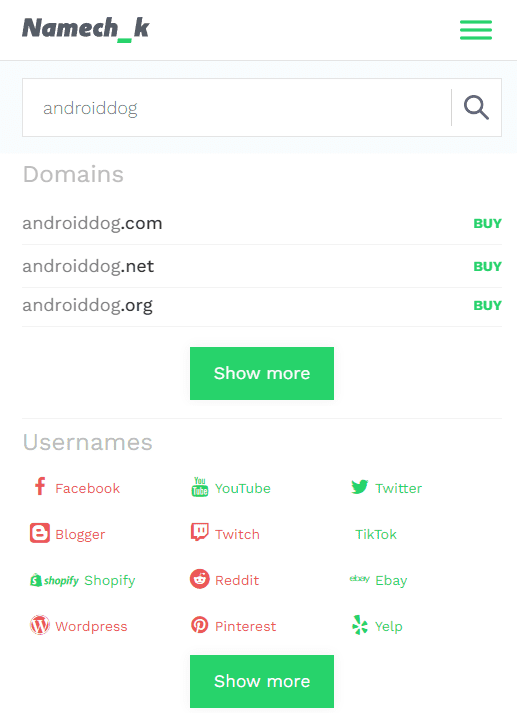
Here are a few things to keep in mind when selecting a domain name:
- Choose a .com domain name. 86% of the internet uses .com, so your visitors are likely to try visiting your blog by typing .com. Avoid other extensions like .net or .org.
- Don’t include hyphens and numbers.
- Do not use words with multiple spellings (for example colour vs color).
- Shorter domain names are better. Try to keep it under 12 characters.
- Spelling & Pronunciation should be easy and intuitive.
- It should be easy to remember.
- Avoid words that can be misread together. For example, therapistjohn.com can be read as Therapist John or The Rapist John.
- Make sure it’s not trademarked or copyrighted by someone else. The AI writing software Jarvis.ai had to rebrand to Jasper.ai because Marvel sued them for the Iron Man reference. Lawsuits will happen once your blog is established.
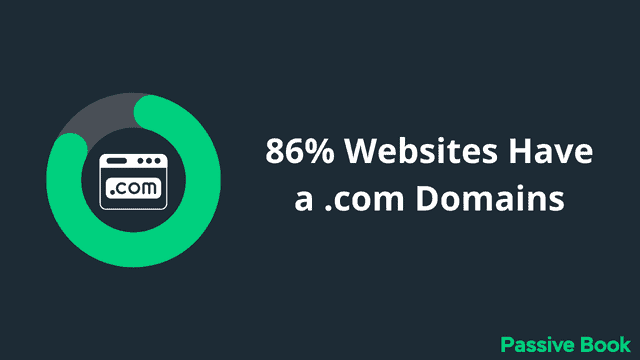
Register a Domain Name
Once you decide your domain name it is time to register it.
You should register your domain with NameCheap because you will get domain privacy for free. Other providers charge $12 per year for domain privacy. Without domain privacy, your name, home & email address will be accessible to the public.
Step 1: Go to NameCheap. Enter your domain name with the .com extension.
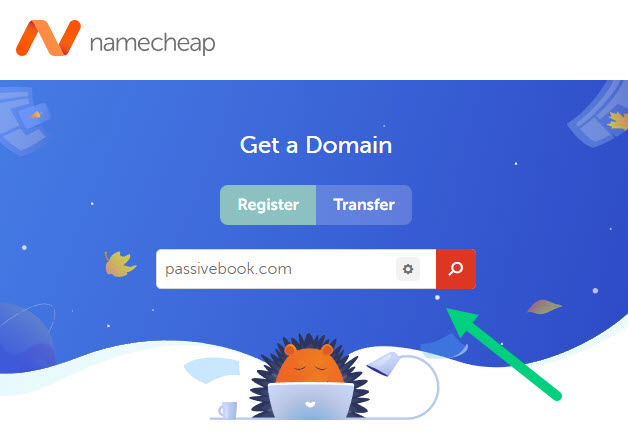
Step 2: Select the .com extension and click the Add to Cart button.
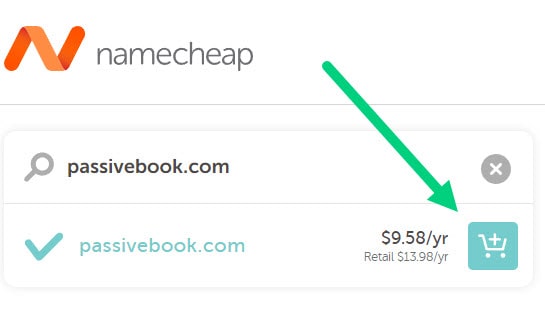
Step 3: After adding the domain to the cart, click on the Checkout button.
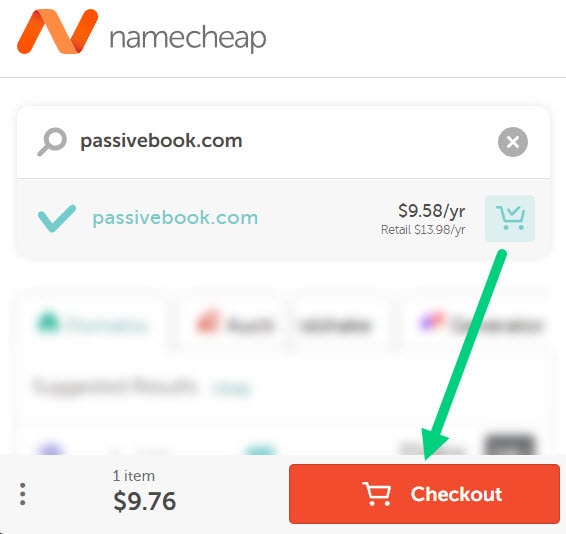
Step 4: Enable Domain Privacy that comes for free along with auto-renew. You don’t need any other paid addon.
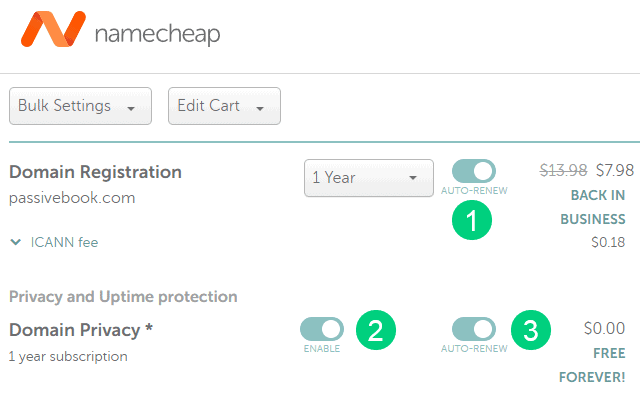
Step 5: Click on Confirm Order. Pay to complete your purchase.

Step 6: Log in to Namecheap and click on Domain List ❶ in the left sidebar and then click Manage ❷ next to the domain you just purchased.
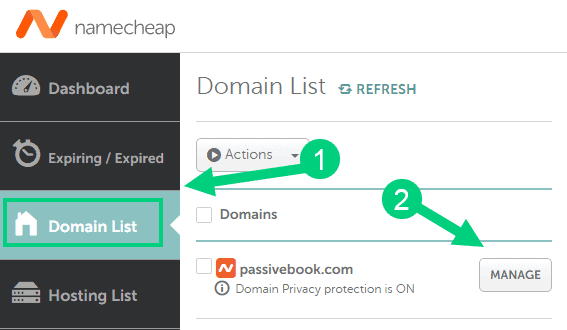
Step 7: Under the Nameservers section, select “Custom DNS” from the dropdown ❶. Then enter the following two nameservers ❷ ns1.bluehost.com and ns2.bluehost.com as shown in the image. Then click the green tick ❸ to save. If you use a hosting provider other than Bluehost, enter their nameserver values in this step instead.
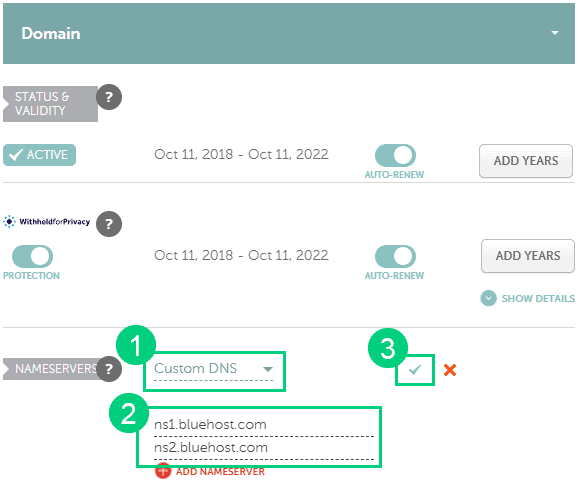
Can I get a free domain name?
Your web hosting provider might give you a free domain name for one year but they charge $12 for domain privacy which is free in Namecheap. From the second year, you will pay for both the domain and privacy which will cost you more than $20+. So it is cheaper to just register your domain with Namecheap from the beginning. Also using different companies for web hosting and domain registration will allow you to easily switch your blog host later without transferring domains.
Can I change the name of my blog later?
You will lose your search engine rankings if you change your blog’s name once it gets links from other websites. It will take as long as a year or more for you to regain the lost traffic. It is possible to mitigate problems by having proper redirects. But you will have to renew both your old and new domains every year. So try to avoid changing your blog’s name once it is established.
4. Setup WordPress
The next step is to get your blog up and running in WordPress.
Why Choose WordPress.org?
There are many blogging platforms but the self-hosted wordpress.org powers 70% of blogs on the internet. 42% of all websites on the internet use WordPress.

Here’s why we recommend using WordPress.org:
- It is free to install and set up in any hosting of your choice.
- Complete control of the design and functionality of your blog. You can make it look the way you want.
- You own your content and can move it wherever you want.
- WordPress is used by some of the biggest brands in the world including Facebook, Coca-Cola, Forbes, The Guardian and Sony Music.
WordPress.org vs WordPress.com
To get started with WordPress, you can either use wordpress.com or wordpress.org.
While both are WordPress products, they are very different from each other.
WordPress.com is a hosted platform that takes care of hosting and security for you but it has strict limitations on customization. You will need to upgrade to a paid plan to unlock most features.
WordPress.org is a self-hosted platform that you need to install on your own web hosting. It is completely free to use and install in the hosting of your choice. You will have full control over the design and functionality of your blog.
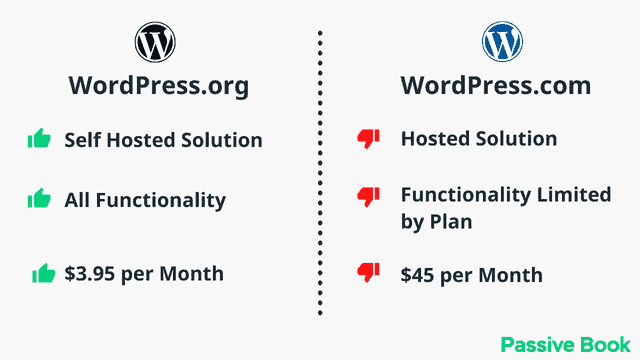
We recommend using WordPress.org because it is the most flexible platform. You can make your blog look however you want and add any features that you need.
Why Avoid Free Blogging Platforms
Free platforms like Blogger and Wix might seem tempting because they are free to use. But there are many reasons why you should avoid them. Here’s why:
- These websites don’t do well in search engines. So you will have a tough time having your blog found.
- Very limited customization options. You will be stuck with the design and layout that they give you.
- You will have to use a subdomain name like yourblog.blogspot.com or yourblog.wix.com. This looks unprofessional and makes it harder to build a brand around your blog.
- It’s hard to move your content if you want to switch to a self-hosted platform later.
- You don’t own your content. The platform can shut down your blog at any time without warning.

How much does it cost to start a Poetry blog?
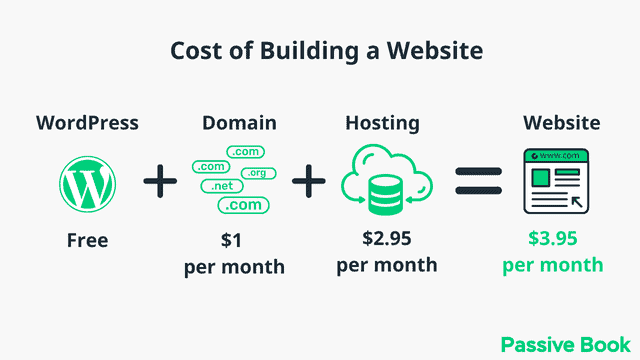
It will cost you $2.95 per month to host your WordPress Poetry blog in Bluehost. A domain will cost you $12/year. So that is a total of $4.2 per month, which is less than the price of Netflix for all the unlimited features that a self-hosted WordPress blog has to offer.
What to do if you already have a free blog?
If you already have a poetry blog on a free platform like Blogger or Tumblr, you can migrate it to WordPress using a free import plugin.
Install WordPress in Hosting
WordPress is free to download and use, but you need a web host to install it on. Web hosts are companies that provide space on their servers so that you can upload your website files and make them accessible to the world.
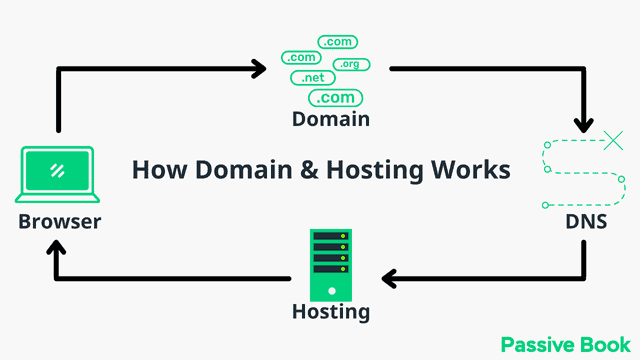
For this guide, we will use BlueHost as our web host. It is a cheap hosting that is extremely easy for beginners to set up. If you use any other web host, the steps will be the same but the user interface may be slightly different.
1. Go to BlueHost using this link to get a special discount. Select WordPress > WordPress Hosting from the top menu.
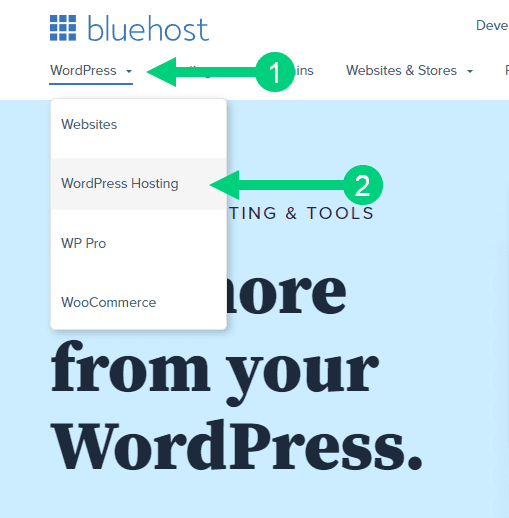
2. Click on the button you see on this page and you will be taken to the pricing section.
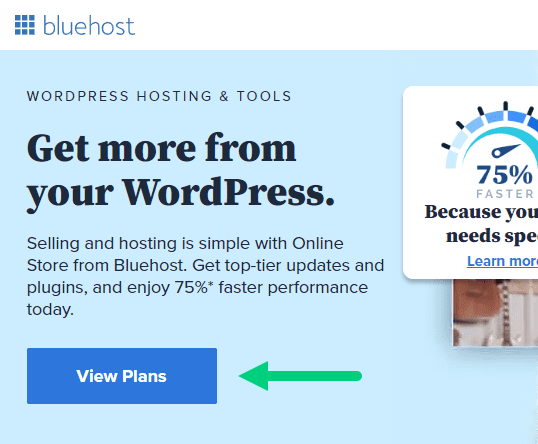
3. Select the Basic Plan. You can upgrade to a different hosting plan as you grow.

4. If you already have a domain name that you purchased with Namecheap you can put that in the “Use a domain you own” ❶ section. If you don’t have a domain name yet, choose the “Create a New Domain” ❷ to purchase a new domain.
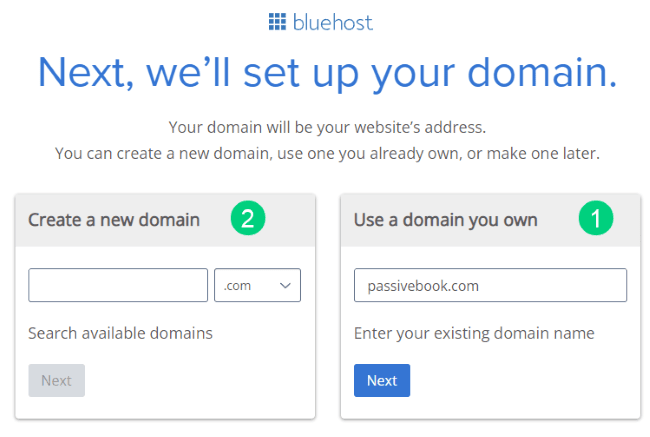
5. In the next screen, enter your information. Uncheck all package extras. If you purchase your domain through Bluehost instead of Namecheap, you may want to enable Domain Privacy. You won’t see the Domain Privacy option if you bought your domain through Namecheap. Namecheap will give you this Domain Privacy for free.
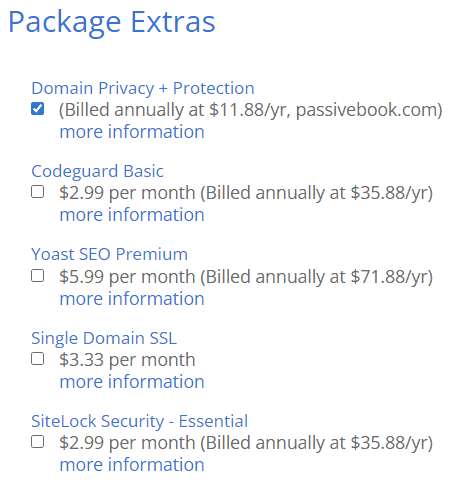
6. Once you have successfully paid, you will be prompted to set a password. Click on the “Create your Password” button.
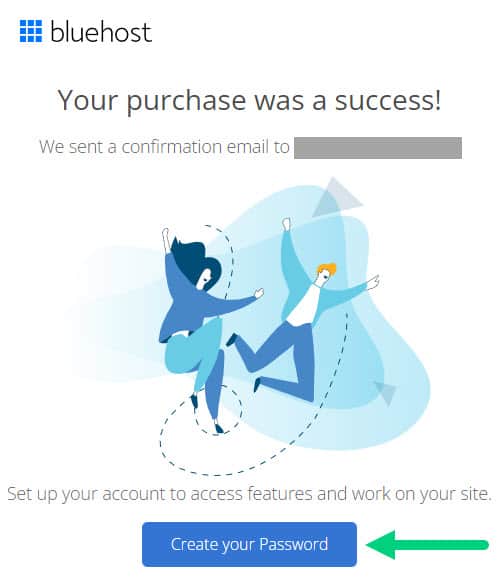
7. Enter your password and create your account. If you lose this password, you can reset it.
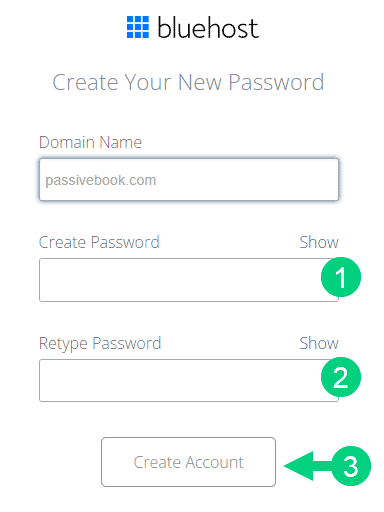
8. After you set your password, log in to Bluehost.
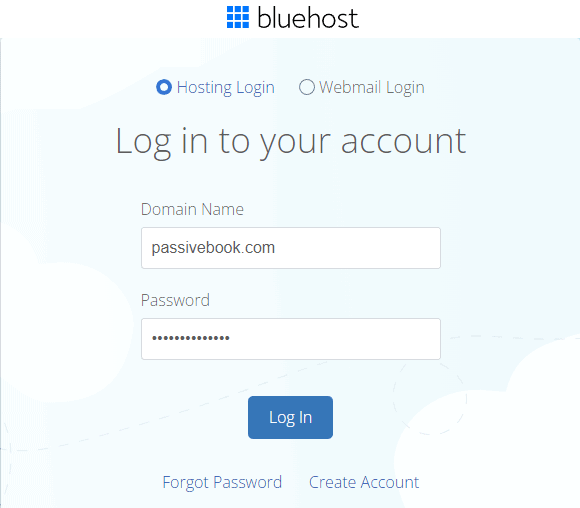
9. Click on the Create your website button on the following screen. This will start a Bluehost Wizard, just click Skip this step wherever possible.

10. On the following page, click “No help needed” or “Skip this step”. We don’t want Bluehost to limit our customization options.
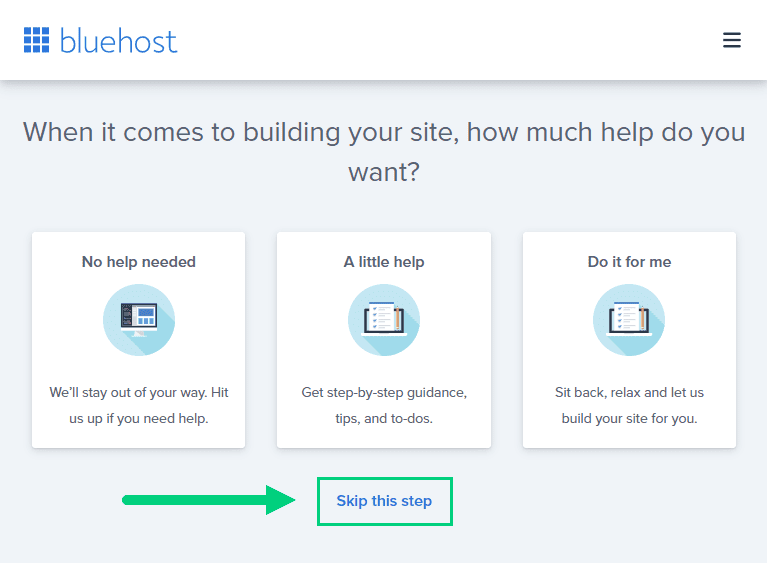
11. On the next page, you will be asked about the purpose of your website. You can choose from any of the available options.
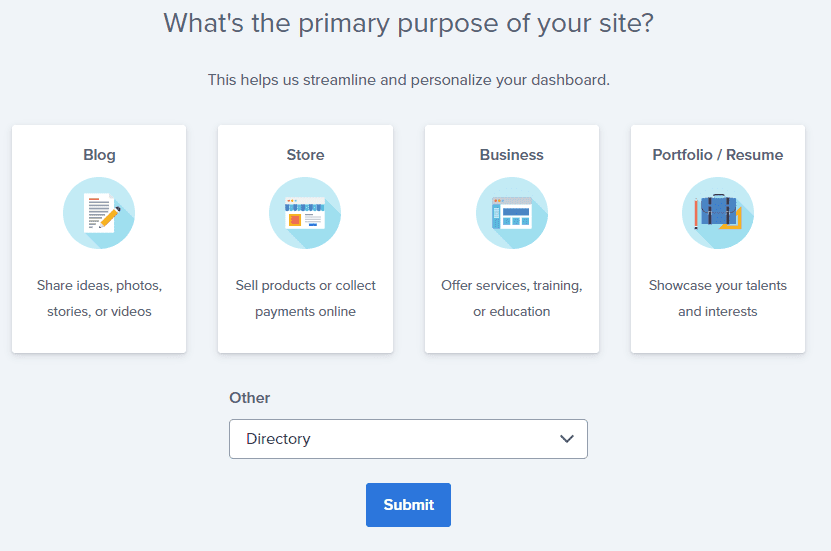
12. On the next page, click Skip this step.
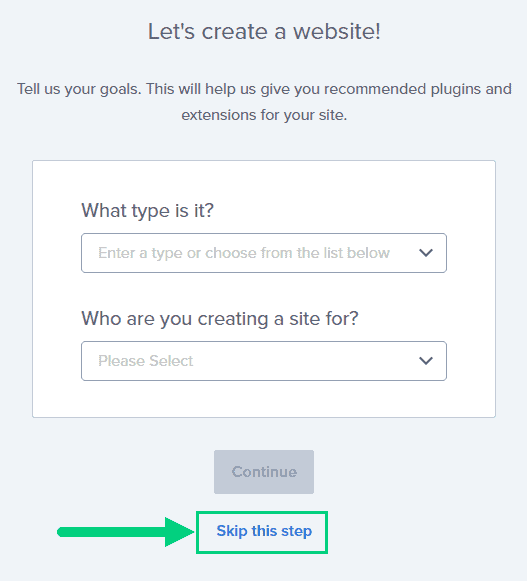
13. On the following page, enter the blog’s name and tagline. You can change this later so feel free to click “Skip this step” or enter something as a placeholder and click Continue.
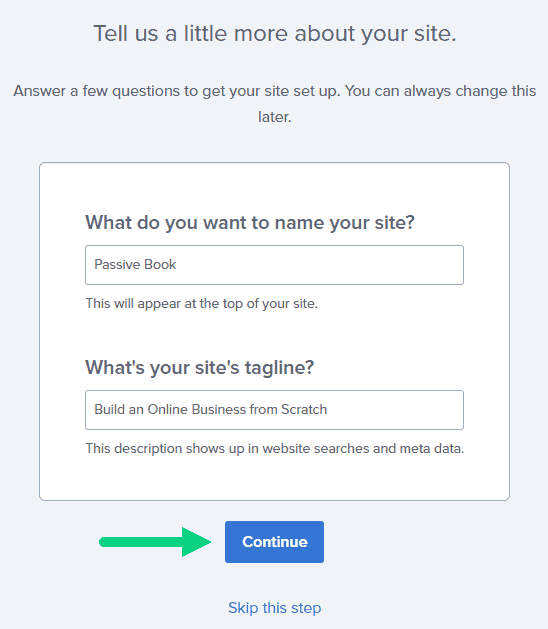
14. Finally you will be asked how you want to build your website. Choose “Limitless customization” to have all the options.

15. You can see your blog by going to yourdomain.com. Go to the Bluehost dashboard and click on the My Sites tab ❶ in the left sidebar and click on the “Manage site” button ❷.
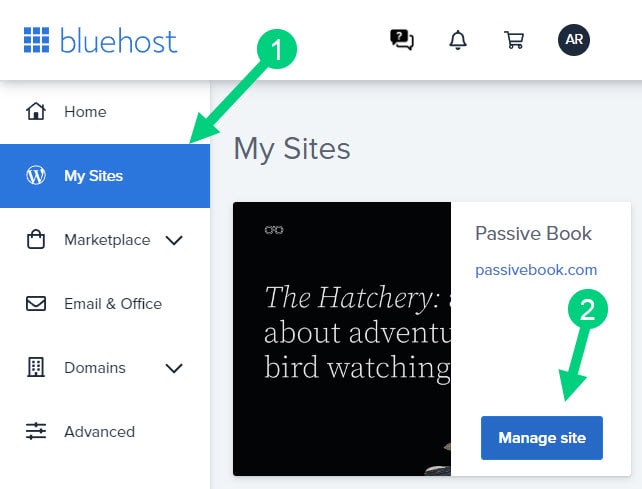
16. Your WordPress site has separate login credentials different from the ones you use to log into Bluehost. You can use this to log in to the WordPress dashboard directly without logging into Bluehost. To get this:
❶ Click on Users on top.
❷ You will be able to see your username and email that you can use to log in to WordPress.
❸ If you click on the three dots you will see the option to Reset your password. ❹
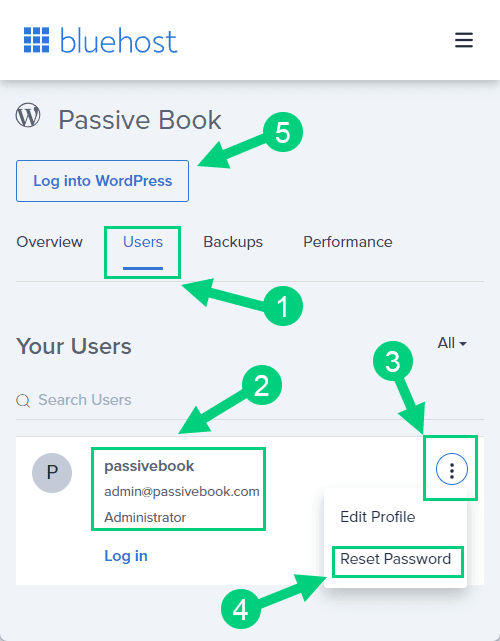
You can log into WordPress from the Bluehost dashboard by clicking the Log in to WordPress button ❺. But it is not recommended you rely on this as your primary login method because you will get locked out of your site if you ever change hosting providers.
17. You will be taken to the WordPress dashboard where you can reset your password ❶. If you don’t like the username Bluehost created for you, you can Add a New User ❷.

18. If you are adding a new user make sure you specify the user role as Administrator ❶. You can log in as the new user and safely delete the default user created by Bluehost.
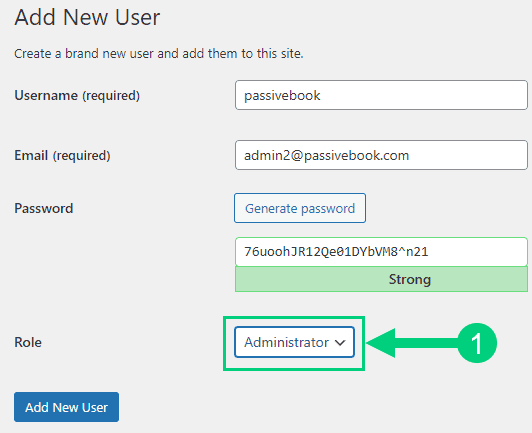
Congratulations! You have successfully set up WordPress.
Configure WordPress
Now that you have the basic version of WordPress installed, it is time to customize it to make it look and feel the way you want.
Login to WordPress Dashboard
Visit yourdomain.com/wp-admin to access the WordPress dashboard.
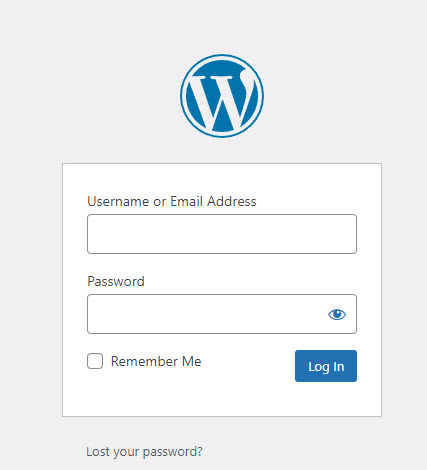
The WordPress Dashboard is the central control panel for your WordPress site. It is where you will go to edit your posts and pages, add new content, manage your users, configure settings, and more.
Use the Email and Password you provided during installation to log in to your WordPress dashboard. If you don’t have a password, use the “Lost your password?” to generate a new password.
Install WP Themes
A WordPress Theme is a collection of files that control the appearance and functionality of your WordPress site.
Your new WordPress blog will be installed with a default blog theme that doesn’t look very great.
To install a new WordPress Theme:
Go to Appearance > Themes > Add New in your WordPress dashboard.
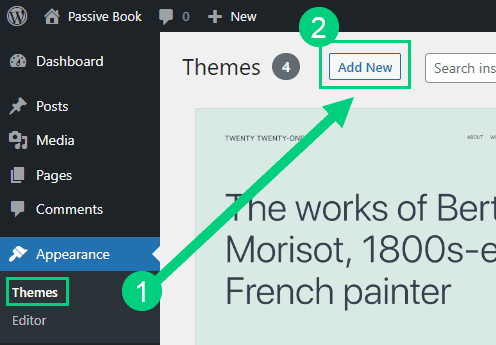
Use the search to find a theme that you like ❶. Before you install the theme, you can see a demo of the theme and learn about its features from the preview screen ❷. If you like the theme, you can install it by clicking the install button ❸. You can also upload a theme from a file on your computer ❹.
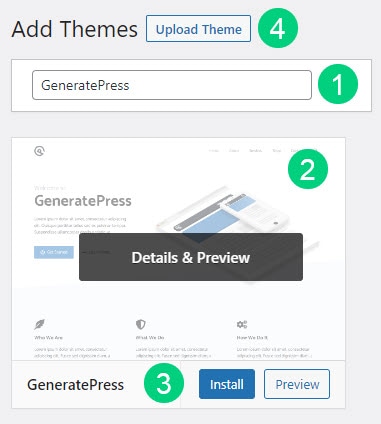
Once installed, click the Activate button to enable the theme.
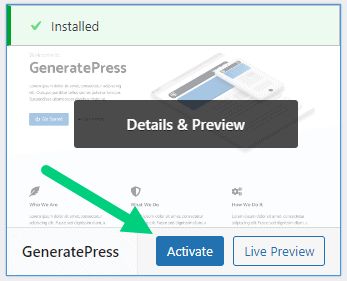
Although you can use a free theme (there are thousands of free themes available), we recommend using a premium theme.
Premium themes not only reduce your website’s load time but also help you customize your website to your heart’s desire.
Here are the premium themes we recommend:
There are also several custom-made poetry blog themes. These themes tend to be bloated with poor code which will slow down the performance of your website. We suggest getting one of our recommended themes for a fast website with unlimited customization possibilities.
Install WP Plugins
A WordPress Plugin is software that adds features and functionality to your WordPress site.
Too many wordpress plugins can slow down your blog site. So before you install new plugins, it will be worth clearing out any existing plugins that your hosting provider installed by default.
Plugins first need to be deactivated before they can be deleted.
❶ Go to WP Admin > Plugins > Installed Plugins
❷ Click on the checkbox to select all plugins.
❸ Select Deactivate from the drop-down.
❹ Click Apply.
❺ Repeat the above steps but select “Delete” instead of “Deactivate” from the dropdown in ❸ to delete all the deactivated plugins.
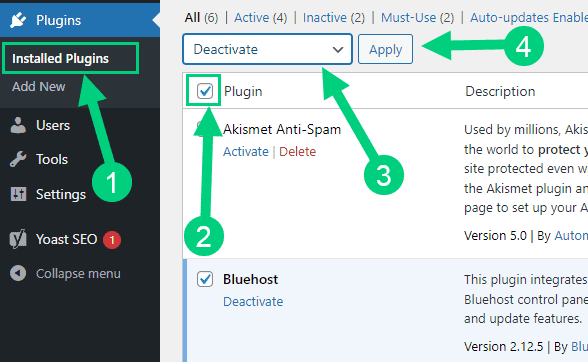
To install new plugins go to the WP Admin > Plugins > Add New.
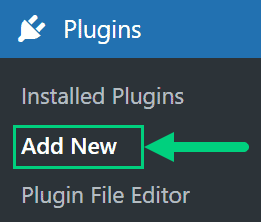
On the plugins page:
❶ Search for the plugin you want in the search bar
❷ Click Install Now. Once you install the plugin, you must also activate the plugin for it to be enabled.
❸ If you are installing a paid plugin you can upload the plugin instead.
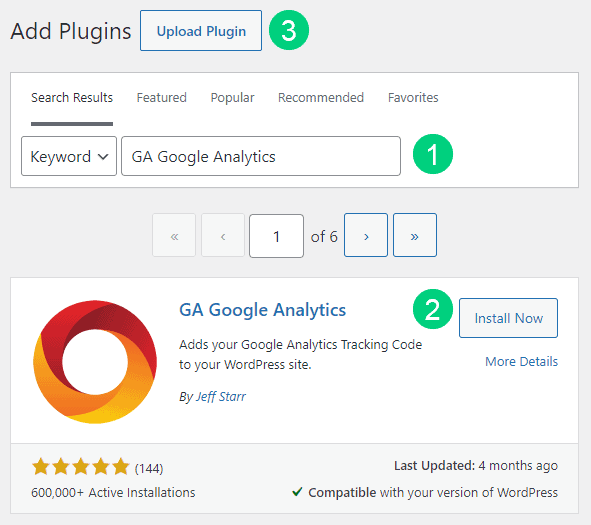
There are many different Poetry blog plugins that you can install, but here are the ones which we recommend:
Backup Plugin: A WordPress Backup plugin helps you create backups of your website so that you can restore your website if something goes wrong.
Recommended Plugin: WPVivid (paid) or UpdraftPlus (free).
SEO Plugin: A WordPress SEO Plugin helps you improve your website’s search engine rankings.
Recommended Plugin: RankMath (paid).
Google Analytics Plugin: A WordPress Google Analytics Plugin helps you collect data about your website visitors so that you can improve your website’s performance.
Recommended Plugin: RankMath (paid) or GA Google Analytics (free).
Cache Plugin: A WordPress Cache Plugin helps your website load faster by caching your website’s files and reducing the number of requests made to the server.
Recommended Plugin: WP Rocket (paid).
Page Builder Plugin: A WordPress Page Builder Plugin helps you create custom pages and posts for your WordPress site.
Recommended Plugin: Thrive Architect (paid).
Security Plugin: A WordPress Security Plugin helps you protect your WordPress site from security threats.
Recommended Plugin: Wordfence (free).
Social Media Plugin: A WordPress Social Share Plugin helps you share your website content on social media networks.
Recommended Plugin: Easy Social Share Buttons (paid).
Customize WordPress
Once you have installed your theme and plugins, it is time to customize the wordpress blog platform:
Change Colors, Fonts & Spacing
You can set the font, colors, and spacing by going to Appearance > Customize in your WordPress dashboard. Premium themes like GeneratePress allow you to customize every aspect of your blog.

Check out our Blog Fonts & Typography guide to choose the right font and typography settings for your blog.
Add Your Logo
Get a logo designed for your blog from Fiverr. Then set the logo of your blog by going to Appearance > Customize in your WordPress dashboard. A logo is not required for a successful blog but it can definitely help appeal to your target audience.
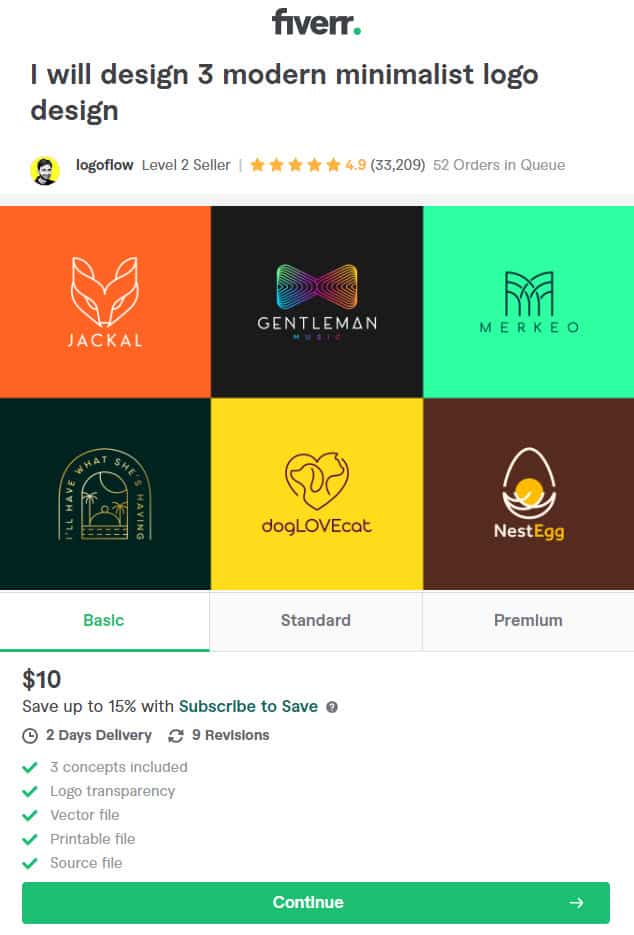
Change Favicon
Favicon is the image that appears in the browser tab and bookmarks. Set the Favicon from the Appearance > Customize section of the WordPress dashboard.

Create Menus
The header and the footer menu can be set from the Appearance > Menus in your WordPress blog dashboard.
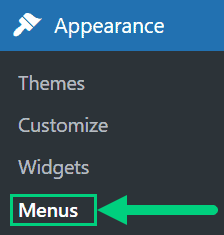
You can nest menu items so that it appears as a dropdown menu ❶. You can use the menu as your primary or secondary navigation menu ❷. Don’t forget to save your menu ❸.
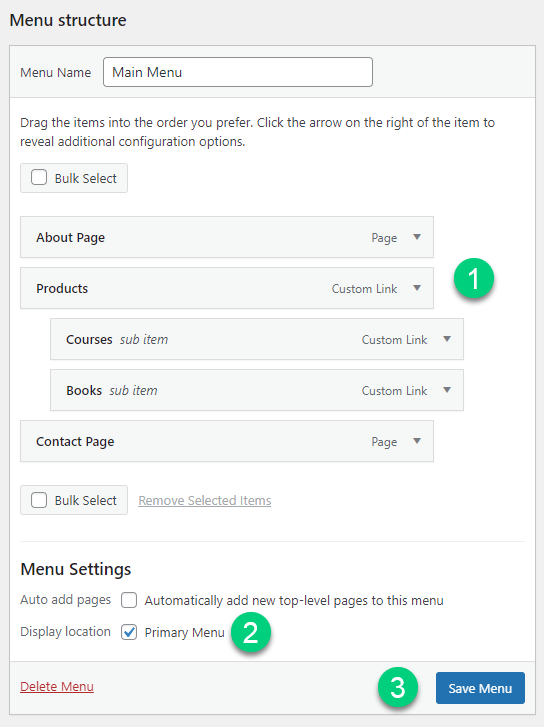
Create Widgets
If you have a sidebar, you can add widgets to it. Go to Appearance > Widgets in your WordPress admin dashboard.
Check out the list of the most useful Blog Widgets and how to add them to your blog.

Set Title & Tag Line
The next step is to change your General Settings. Go to Settings > General in the WordPress Admin area.
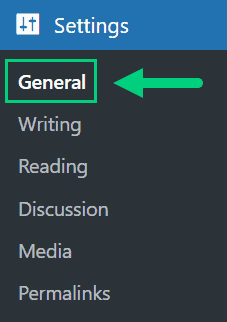
You can set your Site Title, Tagline, and Time Zone from this screen.
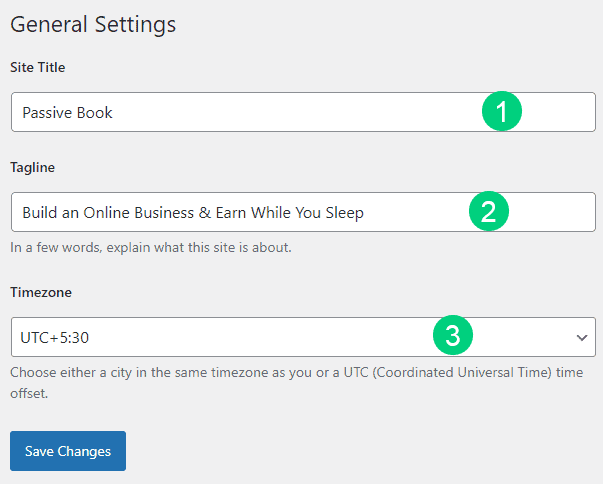
Set Permalinks
The ideal URL structure for SEO is yourdomain.com/sample-post. Set your permalink structure by going to Settings > Permalinks in your WordPress blog dashboard.

Select the “Post name” radio button and save changes.
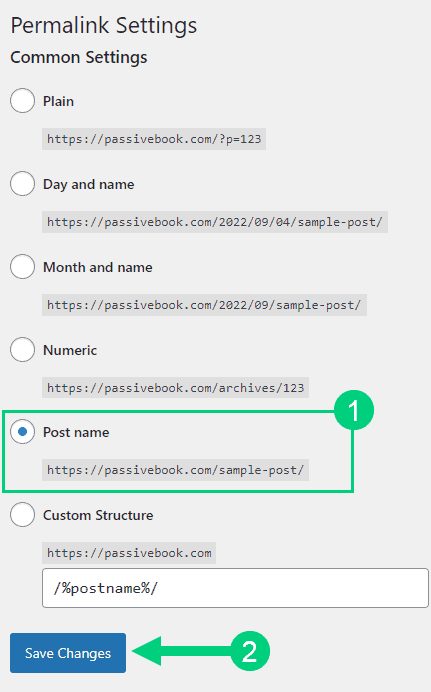
Enable Search Visibility
Chances are you want your blog to show up on Google so people can find you. Go to Settings > Reading in your WordPress dashboard.
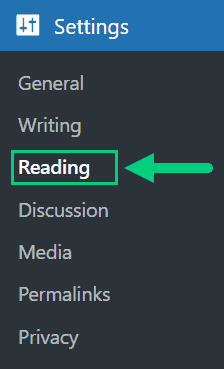
To get search engine traffic, ensure the checkbox “Disable search engines from indexing this site” is Unchecked. You can find this option in Settings > Reading. Most of the time this should be unchecked by default but if it is not, then uncheck it to ensure your site gets traffic from search engines.
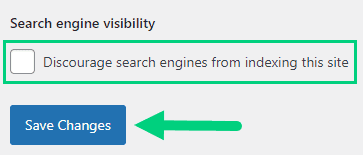
Adjust Comment Settings
Next, you will want to change the Discussion Setting (aka Comments). Go to Settings > Discussion in your WordPress admin area.
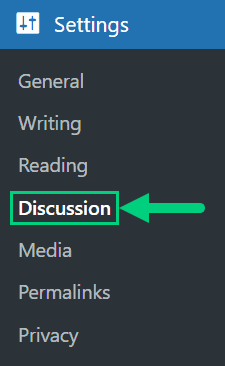
❶ You may want to enable or disable comments on this page. You can also disable pingbacks and enable comment moderation.
❷ You can also set comment approval settings.
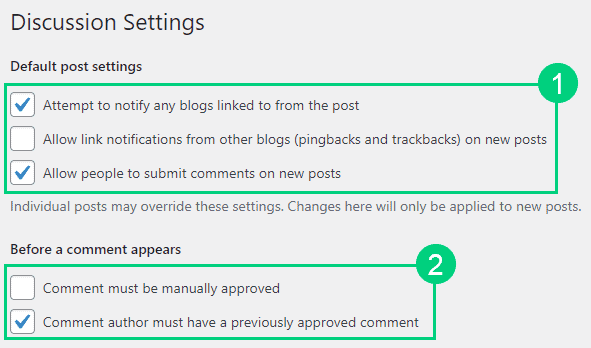
If you want to design your blog further, check out our dedicated guide on blog design which has all our best blog design recommendations.
Create Static Pages
There are a few essential pages that you need to create for your Poetry blog before you can start blogging.
Use pages in WordPress to add static content. Go to WP Dashboard > Pages > Add New.
- Write the headline of your content.
- Populate the body content
- Click the publish button.
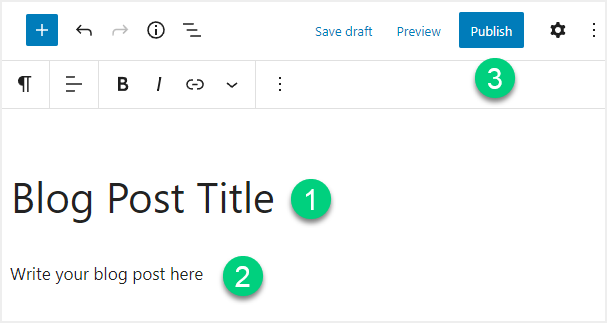
You may want to create the following pages:
Home Page
A home page is the page that your website visitors see when they first visit your website. It usually contains a brief description of your website and a list of your website’s main sections.
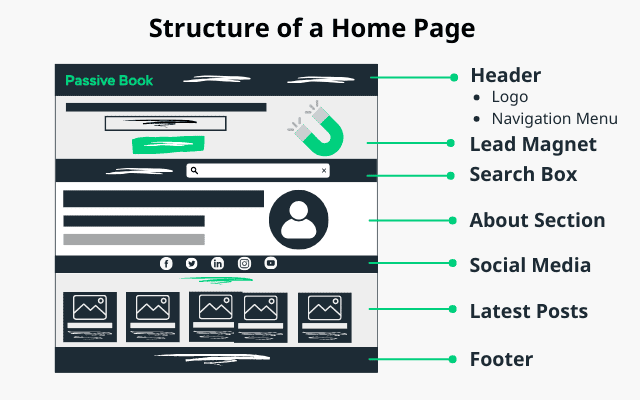
You can create a professional home page for your Poetry blog using a page builder like Thrive Architect.
About Page
An about page is a page that tells your website visitors, who you are and what your website is about.
Your About page should be brief, but it should also be engaging so that your website visitors will want to learn more about you and your website.
The About page is one of the most important pages on your website, so make sure that you take the time to create a strong About page for your Poetry blog.
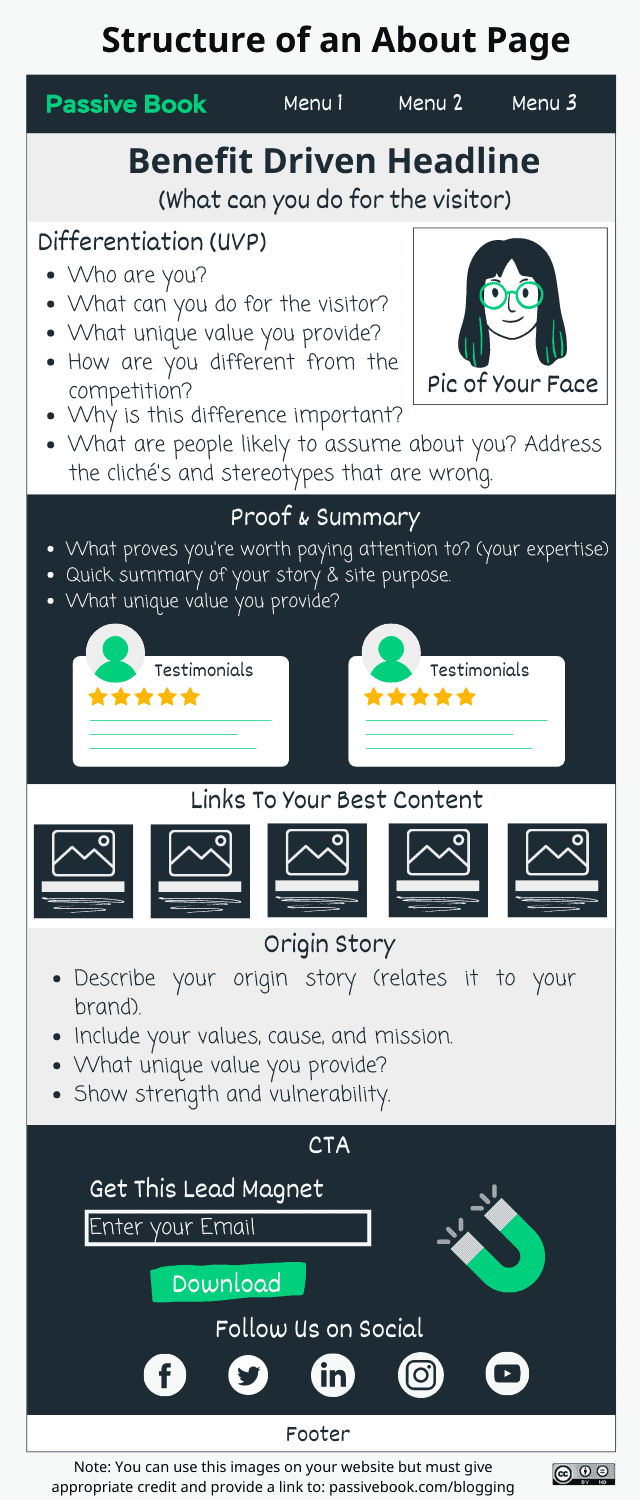
Contact Page
A contact page is a page where your website visitors can contact you. It should contain your contact information, such as your email address and phone number.
You can also use a contact form plugin to create a contact form for your website. This will make it easy for your website visitors to contact you.
Use contact form plugins like Fluent Forms to create the form on your contact page.
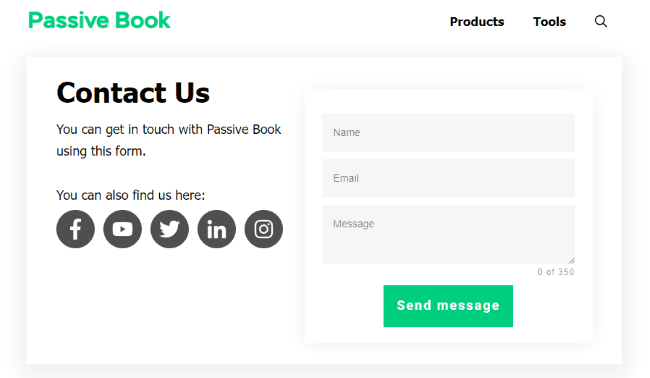
Privacy Policy
A privacy policy page is a page where you tell your website visitors how you collect, use, and protect their personal information.
You should include a link to your privacy policy page in the footer of your website so that your website visitors can easily find it.
WordPress generates its own privacy policy for you. But you can also use a tool like Termly to generate your own privacy policy.
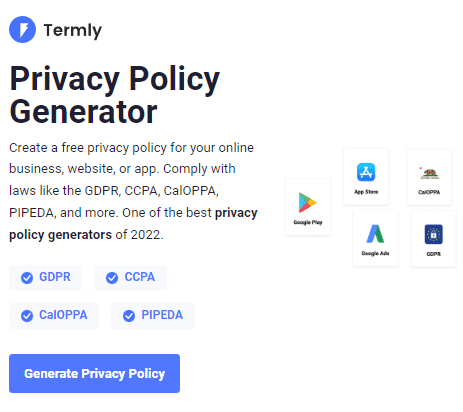
Terms of Service
A terms of service page is a page where you tell your website visitors what they can and cannot do on your website.
You should include a link to your terms of service page in the footer of your website so that your website visitors can easily find it.
Use a terms & conditions generator like Termly to create it.
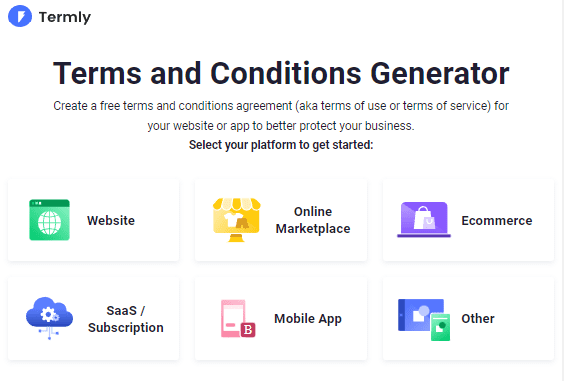
5. Write & Publish Blog Posts
Now that you have your Poetry blog set up, it’s time to write and publish your first blog post. To craft the perfect blog post, check out our in-depth guide on How to Write A Blog Post. Here we will go over specific tips for a poetry blog.
1. Brainstorm Topics
You should brainstorm 100 topic ideas for your Poetry blog. This will ensure that you always have content to write about in your poetry blog.
The goal is to find topics for your poetry blog that your audience is searching for in Google. The type of content you write on your Poetry blog will depend on your specific niche.
Here are a few poetry blog post ideas, you can potentially cover in your poetry blog:
- Poetry Recommendations
- Poetry Writing Tips & Guides
- Poetry Reviews & Critiques
- Interviews
- Discussion on Poetry
- Your Own Poetry
There are a few ways to brainstorm specific content:
Look at Competitors
Look at the articles your competitors are writing about. Chances are, they are writing about the same topics that you are. This is a good thing because it means that there is demand for this type of content.
To identify your competitors, just type in your keyword in Google and see the top results. For example, if you search for “poetry writing tips”, you will find many blogs that cover that topic.
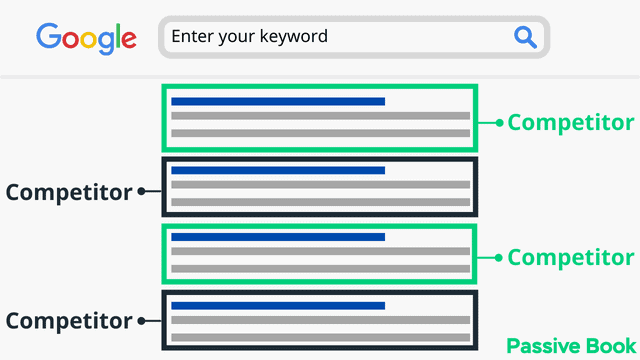
Do Keyword Research
Plugging your keyword into a keyword research tool will give you other relevant keywords on the topic.
This will help you come up with more blog post ideas that you can write about in your poetry blog.
A free keyword research tool you can use is KeywordTool.io.
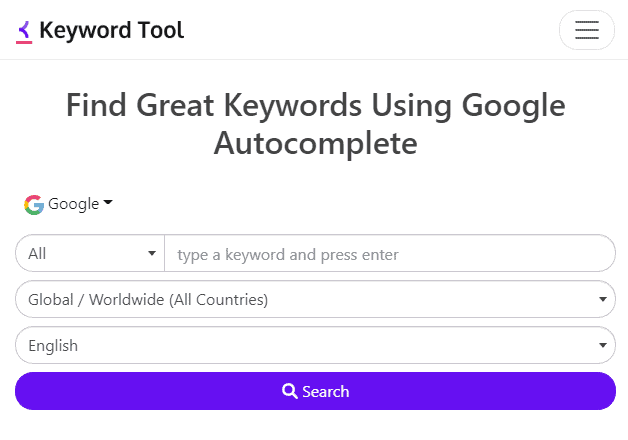
Community & Forums
You can also join relevant poetry communities and forums in your niche. There you will be able to find out what people are talking about and what questions they have.
This is a great way to come up with content ideas because you are directly getting it from the source – your target audience.
2. Create an Editorial Calendar
An editorial calendar is a tool that will help you plan and organize your blog posts. It will also help you stay on track with your content marketing strategy.
An editorial calendar should include the following:
- The topic
- The keywords you will be targeting
- The date you plan to publish
- The author
- Any images you plan to use
- Any other important details
Download Content Calendar Template

Steal our exclusive content calendar template. Have it delivered directly to your inbox:
There are many different ways to create an editorial calendar. You can use a tool like Google Sheets or Trello.
3. Write a Blog Post
Now it’s time to start writing your blog post.
When writing a general blog post, there are a few things you should keep in mind:
- Write for your audience first, not for search engines
- Write in a clear and concise manner
- Use short paragraphs
- Use subheadings to break up your content
- Use images, infographics, and videos to break up your content
- Use examples and case studies to support your points
Writing Poems
If you want to write poems for your poetry blog, you want to ensure that it gets found in the search engines. People usually tend to google keywords like “nature poems” or “haiku poems” and these keywords are unlikely to appear in your actual poem.

So one tip is to write a short introduction before your actual poem that includes this keyword. That way search engines will have the keyword it needs to rank your poems.
Poetry Recommendations
One of the most popular types of content in poetry blogs is recommendations. In this type of content, you will be recommending different poems to your audience.
This could be a listicle of your top 10 favorite poems or a review of a specific poem.

When writing recommendations, you should:
- Be clear about what type of recommendations you are giving
- Explain why you are recommending the poems
- Use external links to link to the poems you are recommending
Poetry Writing Tips & Guides
Another popular type of content in poetry blogs is tips and guides. In this type of content, you will be giving your audience advice on different aspects of poetry writing.
This could be a guide on how to write a poem or a list of tips on improving your poetry writing.

When writing tips and guides, you should:
- Be clear about what type of advice you are giving
- Explain why your advice is valuable
- Use examples to support your points
Poetry Reviews & Critiques
In reviews and critiques, you will be giving your opinion on different poems.
This could be a review of a specific poem, or a critique of a poet’s work.

When writing this post, you should:
- Be clear about what type of review or critique you are giving
- Explain why you feel the way you do about the poem or poet
- Use external links to link to the poem or poet you are reviewing
Interview of Poets
In this type of post, you will be interviewing different poets.
This could be a pre-recorded interview or a written interview.

When writing interviews, you should:
- Be clear about what type of interview it is
- Introduce the poet you are interviewing
- Ask questions that will be interesting to your audience
- Use external links to link to the poet’s work
Writer 5x Faster with AI
You can write your new blog post at 5x speed using the AI writing software Jasper. I was able to write over a hundred blog articles in 3 months using Jasper. This blog article you are reading right now was written with the help of Jasper. AI will not only help you write blog posts fast but also with higher quality.
Jasper can write plagiarism-free blog content, articles, social media content, emails, and ad copy. All you have to do is provide a few inputs on what you want and Jasper will do all the hard work of creating the blog content for you. No more writer’s block.
Check out the video below to see Jasper in action:
Try Jasper for free using the links on this page and get 10,000 bonus credits you can use to start writing your first articles.
Once you sign up for Jasper I recommend you spend some time going through the tutorial videos in the Jasper Bootcamp to truly unlock the power of this amazing software.
Check out our guide on How to Write a Blog Post Fast in 15 mins Without Losing Quality for more tips to write fast.
Outsource Writing
If you don’t have the time or energy to write content for your Poetry blog, you can always outsource it.
There are many different places where you can find writers, such as Fiverr, Upwork, and iWriter.

When outsourcing your content, you should:
- Make sure the writer understands your target audience.
- Make sure the writer understands your poetry blog’s style and tone.
- Give the writer a clear idea of what you want the content to be about.
- Review the content before it is published on your poetry blog.
4. Add Images
Images are an important part of any blog post, and they can help to break up your content and make it more visually appealing.
When choosing images for your poetry blog, you should:
- Use high-quality images
- Use images that are relevant to your content
- Use images that are Creative Commons licensed or royalty-free
- Make sure you have the rights to use any images you include in your content
If you don’t have any high-quality images to use in your blog posts, you can always use stock images. There are many different websites where you can find free stock images:
Free Options: Pixabay, Pexels, Upsplash
Paid Options: Deposit Photos, Shutterstock, iStock, Getty Images, 123rf.
Canva is a free online design tool that allows you to create professional-looking images for your blog posts. Use it to edit your images. If you upgrade to Canva Pro, you’ll have access to even more features, such as a large library of free stock images.

6. Promote Your Poetry Blog
Once you have published your content, you need to promote it to make sure people see it.
There are many different ways you can promote your poetry blog posts, such as:
Search Engine Optimization (SEO)
SEO is the process of optimizing your blog posts so that they rank higher in search engine results pages (SERP). This means that more people will see your content and be more likely to click on it.
There are many different techniques you can use to improve your SEO, such as:
- Including keywords in your blog post titles and throughout your content
- Optimizing your images with keywords by adding alt tags
- Linking to other relevant blog posts and websites in your content
Many factors go into SEO, and it can be a bit confusing to figure out where to start. You can master the more advanced SEO tactics by checking out our SEO Resources.
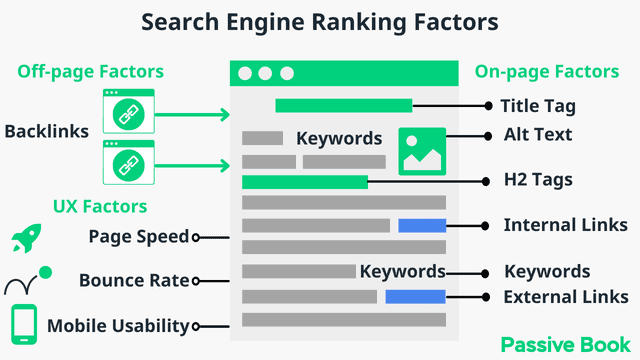
You can ensure you get the basics of SEO right, by completing the recommendations given by the RankMath plugin.
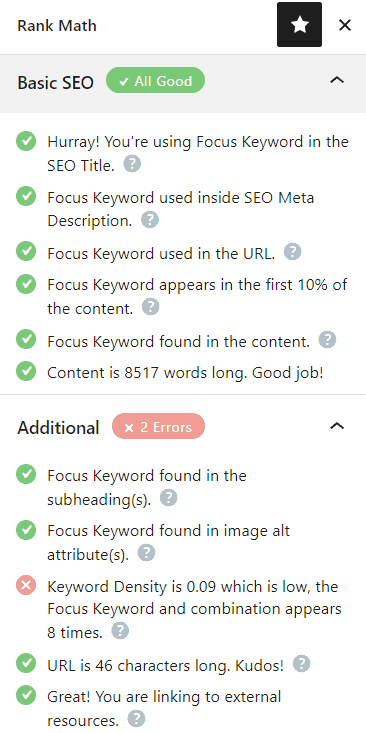
Email Marketing
Email marketing is a great way to promote your poetry blog posts to people who are already interested in what you have to say.
You can use the Thrive Leads plugin to build opt-in forms to collect email addresses. You can then connect the opt-in form to an email marketing service like Active Campaign to send out the emails.

When emailing your subscribers, you should:
- Use an attention-grabbing subject line
- Write a compelling email that tells them what’s in it for them
- Include a link to your blog post
- Add a call-to-action (CTA) telling them what you want them to do next
You can use the Thrive Leads plugin to build opt-in forms to collect email addresses. You can then connect the opt-in form to an email marketing service like Active Campaign to send out the emails.
Check out our Email Marketing resources to learn more.
Social Media Marketing
Social media is a great way to reach new people and promote your Poetry blog posts.
When promoting your content on social media, you should:
- Use attention-grabbing headlines
- Post at the best times for your audience
- Use hashtags to reach a wider audience
- Share visually appealing images
- Include a call-to-action in your posts
Guest Blogging
Guest blogging is when you write a blog post for another website in return for exposure to your own Poetry blog.
This is a great way to reach a new audience and get your name out there.
When guest blogging, you should:
- Choose a website that is relevant to your niche
- Make sure the website has a good reputation
- Write a great blog post that will appeal to their audience
- Include a link back to your own poetry blog in your bio
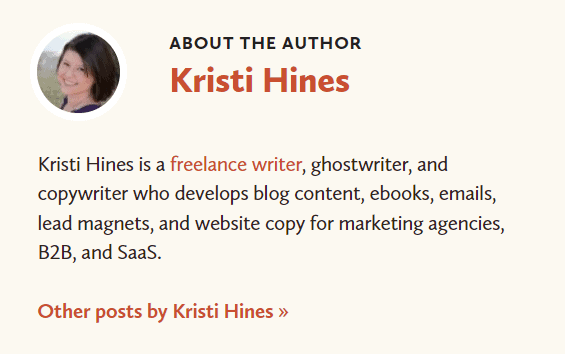
7. Monetize & Make Money
There are many different ways you can make money from your Poetry blog, such as:
Advertising
If you have a lot of traffic to your Poetry blog, you can advertise on your website. This is a great way to make money. You will get paid for every thousand visitors or based on the number of people who click on your ad.
To start advertising on your blog, you can sign up for an ad network like Ezoic (they pay more than Google Adsense). When your blog starts getting more than 100,000 page views a month you can monetize with Adthrive.
| Ad Network | Earnings Per 1K Impressions (EPM) | Monthly Traffic Requirement |
|---|---|---|
| Ad Thrive | $13 | 100,000 |
| Ezoic | $3 | 10,000 |
| Media.net | $1 | – |
| Google Adsense | $1 | – |
Affiliate Marketing
Affiliate marketing is when you promote someone else’s product or service on your Poetry blog and get a commission for every sale you make.
You can promote books that you love in your poetry blog and earn affiliate income. You will make a commission whenever someone clicks your affiliate link and makes a purchase.
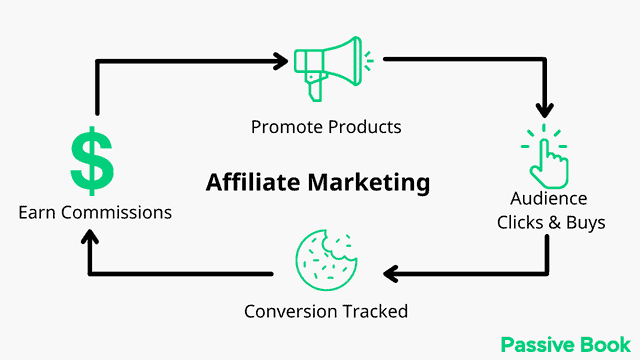
This is a great way to make money because you can promote products that are relevant to your niche and that your audience will be interested in.
There are many different affiliate programs you can join but the best one for your poetry blog will be Amazon Associates. You can promote any book or poetry compilation on Amazon and earn a commission.
Digital Products
Another great way to make money from your Poetry blog is to sell digital products.
This could be an eBook or an online course.
You can compile your poems together and sell them as a poetry book.
You can also teach poetry in a course with video and audio lessons for your students.
You can use Teachable if you want to sell video courses. Your students will have a dedicated course members area and a community system to ask questions and interact with each other. If you only want to sell eBooks, you can use SendOwl which lets you sell your digital products and eBooks for free.
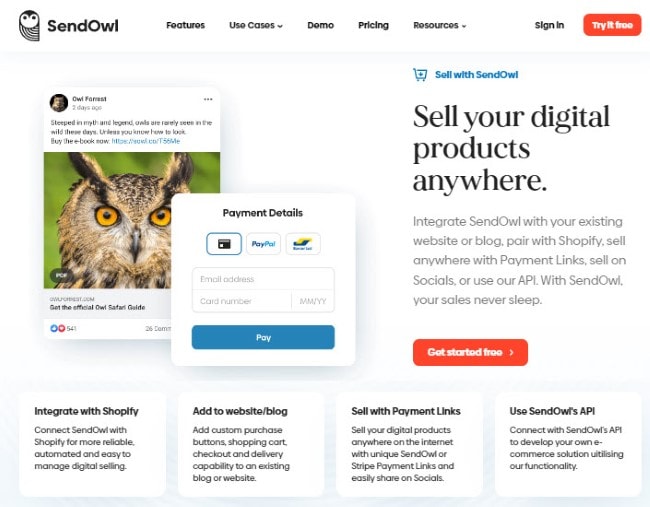
Sell Poems
Many poets submit their work to magazines and websites that pay for poems. You can make anywhere between $15 to $300 per poem.
There are many different websites and magazines that you can submit your poems, such as:
- The Sun
- Poetry Foundation
- The New Yorker
- Three Penny Review
- Epoch
- Grain Magazine
The Sun pays as high as $200 for every accepted poem.

There are also many anthology submissions where you can submit your poems and make money.
Sell Services
As a poet, you can sell services to people who need poems. You can offer writing poetry as a paid service. Many people give a poem as a gift to their loved ones. You can write poems for someone’s valentine, grandmother, or friend as a token of appreciation.
You can list your services in your poetry blog along with websites like Fiverr or Upwork.
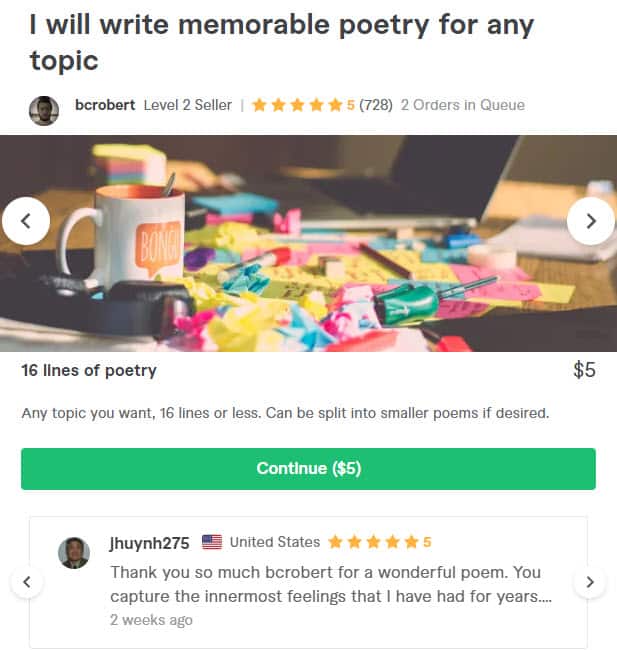
Sell Physical Products
You can have verses of your poetry printed on T-shirts, mugs, pots, and other unique gift items and sell them on your blog. These physical products can be printed on demand.
In print-on-demand, the product is not produced until an order is received from a customer. This means you don’t have to store any inventory and there is no upfront cost for you to setup.

Use Printful to have products printed on demand. You can list your products in marketplaces like Etsy.
FAQ
Here are a few frequently asked questions:
Is a poetry blog a good idea?
A poetry blog can be a great way to reach a new audience and get your name out there. It can also be a great way to make money.
How much traffic do you need to make money from a Poetry blog?
You will need at least 10,000 visitors a month to make a decent income from your poetry blog. Your blog needs at least 100 posts and one year before it starts generating traffic.
What is the best blogging platform for poetry?
The best blogging platform for poetry is WordPress. It is easy to use and has many features that are perfect for poets.
Can you make money from a poetry blog?
Yes, you can make money from a poetry blog by selling advertising space, affiliate marketing, digital products, services, or physical products.
Can I publish my poems in a blog?
Yes, you can publish your poems on your blog. You can also submit them to magazines and websites that pay for poems.
Do I need to copyright my poems?
If you want to publish your poems online or in a book, you will need to copyright them. This will protect your work from being copied without your permission.
How do I start a poetry blog?
The best way to start a poetry blog is to use WordPress. It is easy to use and has many features that are perfect for poets. You can also use a platform like Blogger or Tumblr.
How do I generate traffic to my poetry blog?
The best way to generate traffic to your poetry blog is to use SEO techniques and promote your blog on social media. You can also submit guest posts to other blogs in your niche.
How much money can I make from a poetry blog?
You can make anywhere from $100 to $10,000 per month from a poetry blog. It all depends on how much traffic you can generate and how you monetize your blog.
What Next?
If you have any questions as you set up your new blog, leave a comment below so we can help you out.
Starting a poetry blog is a great way to share your passion for poetry with the world and build an audience around what you love doing. If you invest enough time, you can also make money from your poetry blog.
Remember, the key to success is consistency. The more you write, the better your chances are of becoming a successful poet. So get started today and see where your passion for poetry takes you!
Have you started your poetry blog yet? What type of poetry blog are you going to start? Let us know in the comments.
Share this post with your friends & followers:
